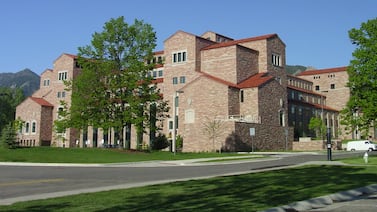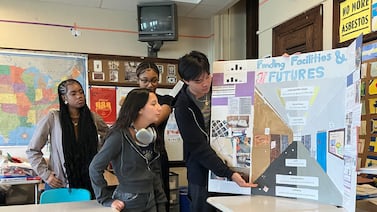This story was produced as part of the Medill Media Teens journalism program for Chicago Public School students at Northwestern University. The writer worked under the mentorship of Medill graduate DeMario Phipps-Smith.
Aristidis Adrahtas loves his job. As an athletic trainer, he plays a part in keeping young athletes healthy in one of the oldest sports conferences in the country – the Chicago Public League.
Adrahtas spends his days providing physical therapy, rehab, and injury evaluation to student athletes. But the job goes beyond that, offering student emotional therapy and support.
Adrahtas says what he provides can be helpful to any sport. But not many Chicago Public Schools students get those benefits.
Though there are more than 80 public high schools across Chicago, Adrahtas can count the number of athletic trainers in the Chicago Public League on two hands.
According to Adrahtas, just six schools have athletic trainers: Lane, Walter Payton, Jones, Whitney Young, Taft, and Von Steuben. All are on the city’s more affluent North Side and all serve a lower proportion of low-income students than the rest of the district.
Joey Gelman, sports communications manager at CPS, confirmed six schools have allotted funds for athletic training services, but did not indicate which ones.
The problem is not unique to Chicago. According to the National Athletic Trainers Association, 42% of schools in Illinois don’t have athletic trainers.
This support on and off the field shouldn’t be something students only get if they are lucky enough to attend a privileged school, said Stacy Lambert, an assistant executive director with the Illinois High School Association who oversees the sports medicine advisory committee.
“They’re extremely important, not only for their medical abilities in being a first responder for a team if a player gets injured,” Lambert said. “I think back to my own high school participation, the athletic trainer is kind of that first person that really checks in with the athlete, prior to a game or to a practice, see how they’re feeling.”
High school athletics and injuries go hand-in-hand. According to the National Athletic Trainers Association, 90% of student athletes nationally report some sort of sports injury.
“Just in sports, injuries happen all the time, no matter who you are,” Adrahtas said. “And somebody to help guide them is huge.”
Jacob Maza, a baseball player and junior at Lane Tech, appreciates the injury prevention and recovery work he does with Adrahtas — everything from a type of massage therapy called cupping to stretching.
“I do a lot of exercises with him for my body,” Maza said. “It’s just like anything that I really need, he has.”
While trainers at games provide immediate help when there’s injuries, as Maza says, much of their benefits come away from the actual games.
Through learning and communication with Adrahtas, Maza has explored the field as a potential career in his post-playing days.
“I’ve now recently kind of looked into becoming a physical therapist, in college and having that as my major,” Maza said. “Because I would just love to do what he does.”
While all of those aspects are important, Adrahtas said there are “emergency situations” when athletic trainers and the skills they bring are critical.
“It’s the top 1% of things that happen.” Adrahtas said. “Like for football games, it’s the cervical spine injuries. Kids passing out on the court. Direct blow to the chest that needs CPR, like those upper upper echelon of emergency situations. We’re all trained in that and we practice it over and over and over and over and over again. And so we’re prepared for those situations.”
Dan Finger, the head football coach at Whitney Young, recalls a junior varsity game between Young and Richards in 2019, when a Richards athlete was knocked unconscious. He says having the trainer there was “crucial” to make sure the player was OK and to walk the coaches through what needed to happen.
“It was a very, very serious injury,” Finger said. Without the trainer, the incident might not have been handled as well, he said.
Lambert says that injuries most often occur in high contact sports, such as football. But according to Adam Babiarz, the athletic trainer at Taft High School, they find themselves useful for just about every sport.
“There’s a lot of different after-school activities that athletic trainers provide services for,” Babiarz said. “Any after-school activity would benefit from having a certified health care professional on site to treat them in the event that there’s any accidents.”
But in CPS, funding can play a role in the lack of athletic trainers.
At Morgan Park High School, athletic director Ebony Jones said there’s not enough money in the budget to hire an athletic trainer.
“I think the hardest part with trying to get an athletic trainer at a high school – even with as many sports as a Morgan Park, a Kenwood, a Whitney Young, a Lane Tech has – is where does that budget line come from?” Ebony said. “Is that another staff position? How does that get paid?”
But, according to Jones, even if schools had enough money, there aren’t enough athletic trainers.
That problem might not be going away anytime soon. A recent switch in national requirements now means athletic trainers have to get a master’s degree instead of just a bachelor’s. This, according to Babiarz, is going to create a sort of “waiting game,” as potential job candidates take time to earn a more advanced degree.
Schools without athletic trainers often partner with a local clinic or hospital that offers athletic training services.
“Sometimes that’s more difficult to do in certain areas of the state,” Lambert, with IHSA, said.
Another option to increase the number of athletic trainers would be a statewide mandate, though Lambert said IHSA has not considered that. The two main obstacles – finances and available trainers – would remain even with a mandate.
Gelman, with CPS’ Office of Sports Administration, said money is being allocated to a pilot program aimed at increasing the presence of athletic trainers across the Chicago Public League.
That’s welcome news to Babiarz, the athletic trainer at Taft.
“I think every high school in America should have an athletic trainer,” he said.
Alex Burstein is a senior at Lane Tech College Prep High School. Contact Alex on Twitter at @alex_burstein.





